Submitted by Norm Roulet on Thu, 12/30/2010 - 09:44.
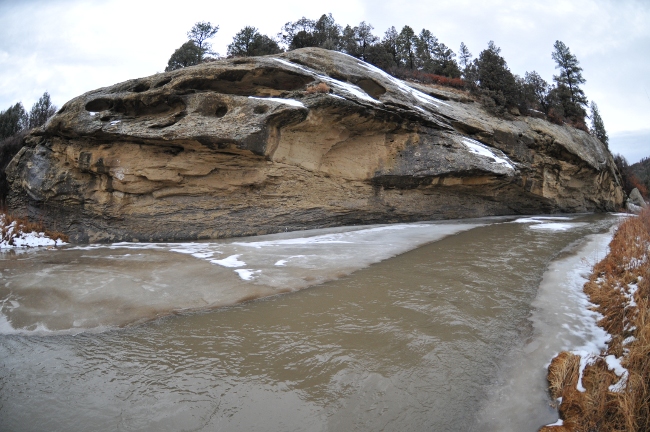
Rock formation at base of Archuleta Mesa, Jicarilla Apache Reservation, Dulce, New Mexico
I was thrilled to recently be invited to the beautiful Jicarilla Apache Nation Headquarters, on the Jicarilla Apache Reservation, in Dulce, New Mexico, to meet with a community development organization there and discuss agriculture, economic development and regeneration of the Earth, with a focus on the future of growing hemp in America.
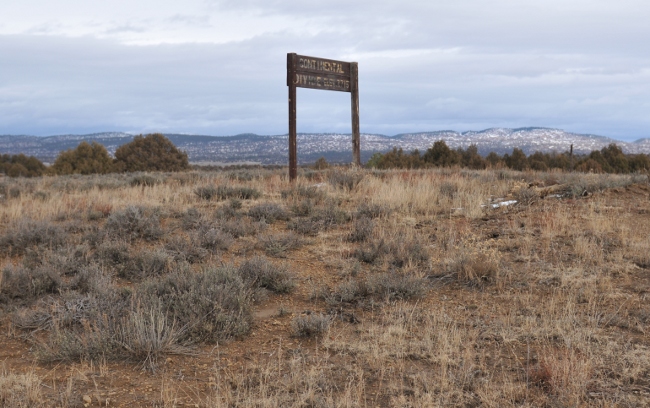
Continental Divide sign on Jicarilla Apache Reservation outside Dulce, New Mexico - Elevation 7,715 feet
There is evidence hemp is native to this land, and Jicarilla laws make it legal for them to grow hemp on their reservation - they do not yet grow hemp here (which is otherwise illegal to grow in the United States), which is something I met with the Jicarilla to discuss changing, in 2011. Their one million acre reservation on the Continental Divide is one of the most unspoiled places on Earth... there is significant native American wildlife and virgin soil never turned by humans here. The Jicarilla have a natural existence and agricultural history in balance with the environment, and they are smart to consider adding hemp to their portfolio of economic development plans.
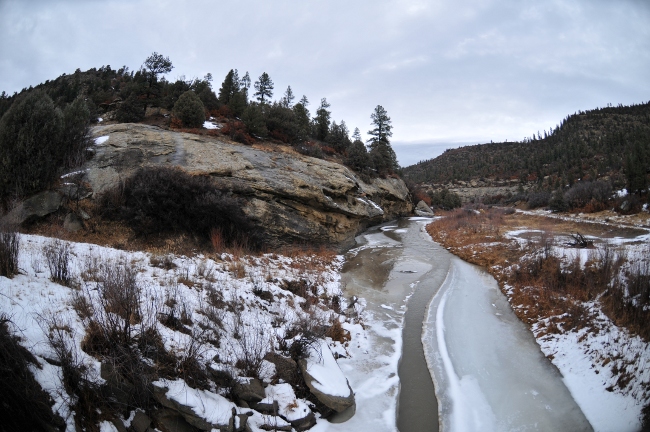
Navajo River through Archuleta Mesa, Jacarilla Apache Reservation north of Dulce, New Mexico
The Jicarilla have a reputation of being smart business people and good stewards of their community, so their community is well kept, and the reservation is spectacular. Revenues from oil and gas exploration and other activities on their reservation make the Jicarilla Apache prosperous, and their capital, Dulce, is a very modern small town of around 2,600 residents - 90+% Native American. It features a modern hospital, new schools, an airstrip, significant new housing, a recent Best Western with casino, and a state-of-the-art headquarters building that offers a dignified home for their government.
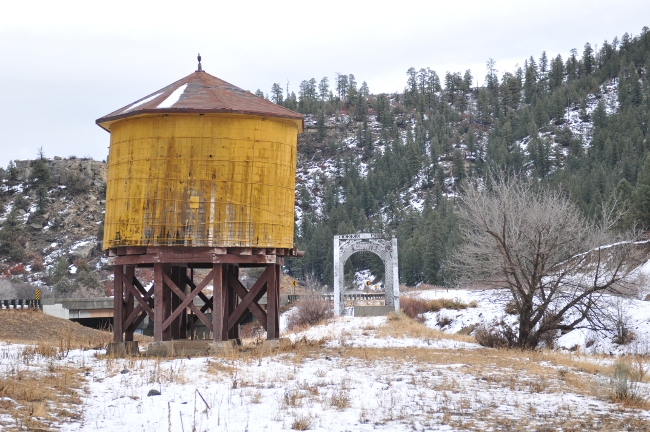
Narrow Gauge rail bridge and water tower on Jicarilla Apache Reservation north of Dulce, New Mexico - out of commission
You drive through some of the most beautiful natural lands on Earth to get to Dulce - including the San Juan National Forest, where I encountered a white-out blizzard - and pass through the silver mining support town of Chama, where is still based the Cumbres and Toltec Scenic Railroad - "Americas Longest & Highest Narrow Gauge Railroad", built in 1880... offering trips over the highest pass with passenger rail service in America. In Dulce, today, you see scant remnants of these rail encroachments of the White Man's mining into these native lands.
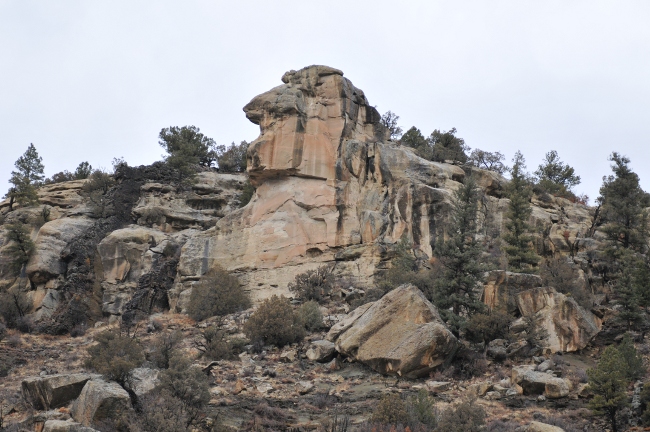
Rock formation of Archuleta Mesa, Jicarilla Apache Reservation, north of Dulce, New Mexico
Jicarilla Country - at 7-8,000 feet, this is a place where legends were made, and live on today.
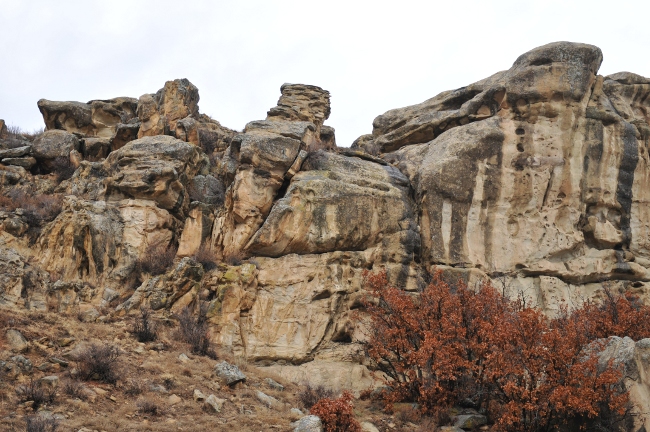
Rock formation of Archuleta Mesa, Jicarilla Apache Reservation, north of Dulce, New Mexico
One group of legends I didn't know about, before coming to Dulce, revolve around theories of a secret US military base under the Archuleta Mesa, just North of Dulce, supposed to house aliens... and there are extensive stories of encounters around here with UFOs, aliens and of cow mutilations... search "Dulce Base" on the internet for the stories. I did not encounter any signs of any of that, and I'm glad I didn't know of these stories before visiting Dulce.... looking for UFOs would have distracted me from enjoying some of the most striking countryside in America.
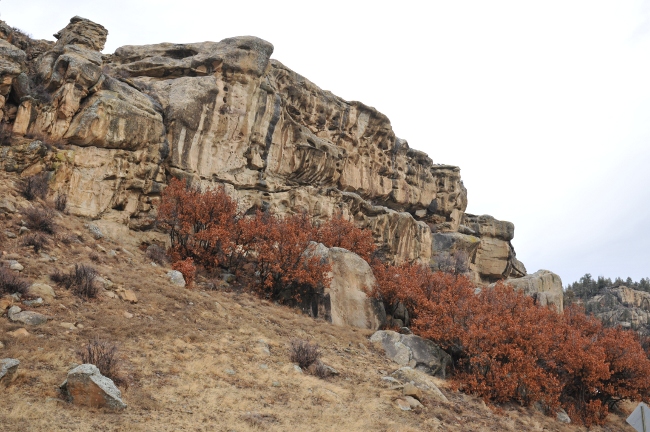
Rock formation of Archuleta Mesa, Jicarilla Apache Reservation, north of Dulce, New Mexico
What I did observe around Dulce, that I found abnormal, was strange discoloration of the cliffs of Archuleta Mesa, north of Dulce, which appears to be caused by dark run-off from the mesa above, which I've not noticed on natural rock formations anywhere else I've been before. It looks like the discoloration on buildings around my house, in Cleveland, from rain streaked coal powerplant soot... although it appears the discoloration in Dulce has been occurring for a very long time - there are places where the stone face of the mesa has fallen off the mesa, over the years, and the areas where newer stone is exposed is not so discolored... this didn't happen over night.
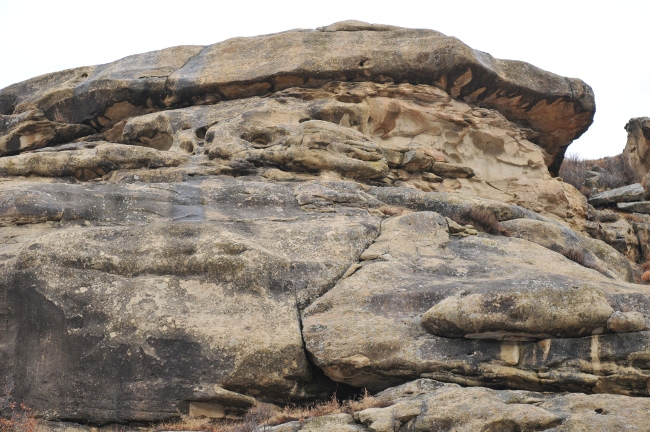
Discoloration on Rock formation of Archuleta Mesa, Jicarilla Apache Reservation, north of Dulce, New Mexico
I'm interested in any geological explanations from observers of these photos and facts on realNEO.
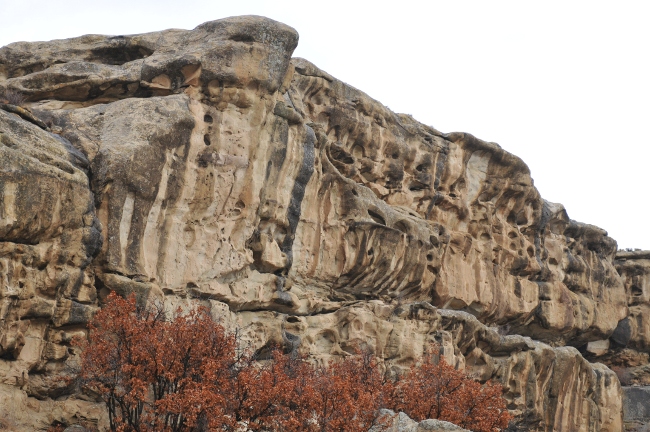
Discoloration on Rock formation of Archuleta Mesa, Jicarilla Apache Reservation, north of Dulce, New Mexico
There have been few major wild fires in this area in the past five Centuries - many of the trees are old growth, dating to a period after a major die-off in the 1580s. Over the last century, known pollution sources around here would include a single narrrow gauge steam rail line, for mining north of this valley, limited motor vehicle traffic in the area, and the emissions from the San Juan coal power plant about 30 miles away (which just recently installed environmental upgrades).

Rock formation of Archuleta Mesa, Jicarilla Apache Reservation, north of Dulce, New Mexico
Perhaps these are the tears of the Black Hactcin - The most powerful of the Hactcin in the underworld - as Jicarilla legend has it that supernatural beings... the Hactcin... made the earth, the underworld beneath it, and the sky above it.
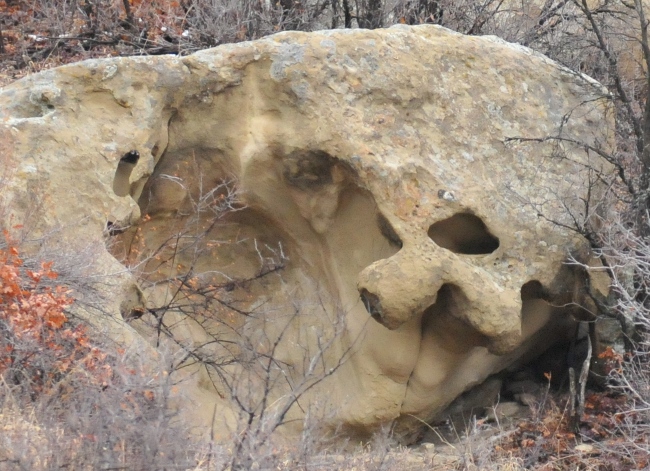
Detail of rock formation at base of Archuleta Mesa, Jicarilla Apache Reservation, Dulce, New Mexico
Perhaps the Black Hactcin is not pleased with the progress of mankind, since he was created. That would explain all the natural and supernatural observations on the Jicarilla Apache lands, since the White Man arrived in America.

Rock formation at base of Archuleta Mesa, Jicarilla Apache Reservation, Dulce, New Mexico
Or, it could just be that the White Man has ruined America, including polluting the most beautiful and natural places on Earth, far beyond human creation, and that shows.
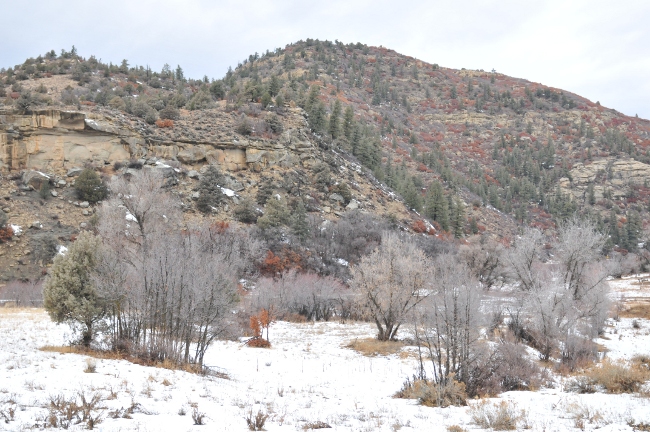
Archuleta Mesa on the Jicarilla Apache Reservation, north of Dulce New Mexico
The Jicarilla Apache creation story tells of the Creation and the emergence of the Jicarilla people, and the sacredness of the number four.
The Hactcin, supernatural beings of the Jicarilla Apache
In the beginning there was nothing - no earth, no living beings. There were only darkness, water, and Cyclone, the wind. There were no humans, but only the Hactcin, the Jicarilla supernatural beings. The Hactcin made the earth, the underworld beneath it, and the sky above it. The earth they made as a woman who faces upward, and the sky they made as a man who faces downward. The Hactcin lived in the underworld, where there was no light. There were mountains and plants in the underworld, and each had its own Hactcin. There were as yet no animals or humans, and everything in the underworld existed in a dream-like state and was spiritual and holy.
Black Hactcin
The most powerful of the Hactcin in the underworld was Black Hactcin. One day Black Hactcin made the first animal with four legs and a tail made of clay. At first he thought it looked peculiar, but when he asked it to walk and saw how gracefully it walked, he decided it was good. Knowing this animal would be lonely, he made many other kinds of animals come from the body of the first. He laughed to see the diversity of the animals he had created. All the animals wanted to know what to eat and where to live, so he divided the foods among them, giving grass to the horse, sheep, and cow, and to others he gave brush, leaves, and pine needles. He sent them out to different places, some to the mountains, some to the deserts, and some to the plains, which is why the animals are found in different places today.
Next Black Hactcin held out his hand and caught a drop of rain. He mixed this with some earth to make mud and made a bird from the mud. At first he wasn't sure he would like what he had made. He asked the bird to fly, and when it did he liked it. He decided the bird too would be lonely, so he grabbed it and whirled it rapidly clockwise. As the bird became dizzy, it saw images of other birds, and when Black Hactcin stopped whirling it, there were indeed many new kinds of birds, all of which live in the air because they were made from a drop of water that came from the air.
Black Hactcin sent the birds out to find places they liked to live, and when they returned he gave each the place that they liked. To feed them, he threw seeds all over the ground. To tease them, however, he turned the seeds into insects, and he watched as they chased after the insects. At a river nearby, he told the birds to drink. Again, however, he couldn't resist teasing them, so he took some moss and made fish, frogs, and the other things that live in water. This frightened the birds as they came to drink, and it is why birds so often hop back in fright as they come down to drink. As some of the birds took off, their feathers fell in the water, and from them came the ducks and other birds that live in the water.
Black Hactcin continued to make more animals and birds. The animals and birds that already existed all spoke the same language, and they held a council. They came to Black Hactcin and asked for a companion. They were concerned that they would be alone when Black Hactcin left them, and Black Hactcin agreed to make something to keep them company.
The creation of human beings
He stood facing the east, and then the south, and then the west, and then the north. He had the animals bring him all sorts of materials from across the land, and he traced his outline on the ground. He then set the things that they brought him in the outline. The turquoise that they brought became veins, the red ochre became blood, the coral became skin, the white rock became bones, the Mexican opal became fingernails and teeth, the jet became the pupil, the abalone became the white of the eyes, and the white clay became the marrow of the bones. Pollen, iron ore, and water scum were used too, and Black Hactcin used a dark cloud to make the hair.
The man they had made was lying face down, and it began to rise as the birds watched with excitement. The man arose from prone, to kneeling, to sitting up, and to standing. Four times Black Hactcin told him to speak, and he did. Four times Black Hactcin told him to laugh, and he did. It was likewise with shouting. Then Black Hactcin taught him to walk, and had him run four times in a clockwise circle.
The birds and animals were afraid the man would be lonely, and they asked Black Hactcin give him company. Black Hactcin asked them for some lice, which he put on the man's head. The man went to sleep scratching, and he dreamed that there was a woman beside him. When he awoke, she was there.
They asked Black Hactcin what they would eat, and he told them that the plants and the cloven-hoofed animals would be their food. They asked where they should live. He told them to stay anywhere they liked, which is why the Jicarilla move from place to place.
Ancestral Man and Ancestral Woman
These two, Ancestral Man and Ancestral Woman, had children, and the people multiplied. In those days no one died, although they all lived in darkness. This lasted for many years. Holy Boy, another Apache spirit, was unhappy with the darkness, and he tried to make a sun. As he worked at it, Cyclone came by and told him that White Hactcin had a sun.
Holy Boy went to White Hactcin, who gave him the sun, and he went to Black Hactcin, who gave him the moon. Black Hactcin told Holy Boy how to make a sacred drawing on a buckskin to hold the sun and moon, and Holy Boy, Red Boy, Black Hactcin, and White Hactcin held a ceremony at which White Hactcin released the sun and Black Hactcin released the moon. The light grew stronger as the sun moved from north to south, and eventually it was like daylight is now.
The people didn't know what this was, and the shamans each began to claim that they had power over the sun. On the fourth day, there was an eclipse. After the sun had disappeared, the Hactcins told the shamans to make the sun reappear.
The shamans tried all kinds of tricks, but they couldn't make the sun come back. To solve the problem, White Hactcin turned to the animals and had them bring the foods they ate. With the food and some sand and water, they began to grow a mountain. The mountain grew, but it stopped short of the hole in the sky that led from the underworld to the earth. It turned out that two girls had gone up on the mountain and had trampled the sacred plants and even had defecated there.
White Hactcin, Black Hactcin, Holy Boy, and Red Boy had to go up the mountain and clean it. When they came down, the people sang, and the mountain grew again. It stopped, however, just short of the hole, and when the four went up again they could only see to the other earth. They sent up Fly and Spider, who took four rays of the sun and built a rope ladder to the upper world. Spider was the first one to climb to the upper world, where the sun was bright.
The emergence
White Hactcin, Black Hactcin, Holy Boy, and Red Boy climbed up the ladder, and they found much water on the earth. They sent for the four winds to blow the water away, and Beaver came up to build dams to hold the water in rivers. Spider made threads to catch the sun, and they made the sun go from east to west to light the entire world, not just one side.
Hactcin called for the people to climb up, and for four days they climbed the mountain. At the top they found four ladders. Ancestral Man and Ancestral Woman were the first people to climb up, and the people climbed up into the upper world that we know today. Thus the earth is our mother, and the people climbed up as from a womb.
Then the animals came up, and before long the ladders were worn out. Behind the animals came an old man and an old woman, and they couldn't climb the ladders. No one could get them up, and finally the two realized they had to stay in the underworld. They agreed to stay but told the others they must come back to the underworld eventually, which is why people go to the underworld after death.
Everything in the upper world is alive - the rocks, the trees, the grass, the plants, the fire, the water. Originally they all spoke the Jicarilla Apache language and spoke to the people. The Hactcin, however, decided that it was boring to have all these things speaking the same, so they gave all these things and all the animals different voices.
Eventually the people travelled out clockwise across the land. Different groups would break off and stay behind, and their children would begin to play games in which they used odd languages. The people in these groups began to forget their old languages and use these new ones, which is why now there are many languages. Only one group kept on traveling in the clockwise spiral until they reached the center of the world, and these are the Jicarilla Apaches.
Lichen
http://www.google.com/imgres?imgurl=http://www.dur.ac.uk/prehistoric.art/research/sa_pics/rocks.jpg&imgrefurl=http://www.dur.ac.uk/prehistoric.art/research/sa_home.htm&usg=__zFzRdO6a-61uXg_g6wbN2hSNxM8=&h=600&w=800&sz=100&hl=en&start=221&zoom=1&tbnid=O3grY1g8jODFxM:&tbnh=128&tbnw=181&prev=/images%3Fq%3Dlichen%2Brock%26hl%3Den%26sa%3DG%26biw%3D1276%26bih%3D581%26gbv%3D2%26tbs%3Disch:10%2C5760&itbs=1&iact=hc&vpx=320&vpy=230&dur=3815&hovh=194&hovw=259&tx=129&ty=122&ei=PTIdTeqIFs6TnAeagIG7Dg&oei=BTIdTa-fOcqAnQegm-DxDQ&esq=13&page=13&ndsp=19&ved=1t:429,r:14,s:221&biw=1276&bih=581
Lichen Environmental Monitoring
There do appear to be Lichen or some similar organic matter covering some surfaces of these rocks, and the black areas appear to be where the Lichen is exposed to some run off and discolored black... e.g. dead?! Other areas are green and living colors...
Wikipedia writes Lichen are responsive to Air Pollution - could this be a form of Lichen Environmental Monitoring... in which case, did the Lichen turn black in a short period of time, indicating some environmental stress (e.g. acid rain or climate change)? It should be able to find out from the locals if they have noticed any progression of this discoloration in their lifetimes - analysis of the actual Lichen for metal content, etc., would probably tell much more... I wonder if University of New Mexico explores such things here...
I do understand there have been issues in the area from mining uranium, so you never know what such study of Lichen may reveal...
Clearly there are natural indicators of pollution like Lichen we may monitor to understand stresses in our environment
From Wikipedia, regarding Lichen response to air pollution...
Disrupt IT
Desert Varnish seems a factor
I do see signs of Lichten - and also of Desert Varnish, which is little understood and may be found on Mars...
Common in the Four Corners region...
Caused by manganese, but they can;t figure out why there is manganese there... making this explanation stranger than expected...
Some interesting things about Manganese in Desert Varnish
Some interesting things about Manganese in Desert Varnish - from Wikipedia...
First of all, it isn't mined or produced in North America, although we import and use huge amounts of it and have forever...
As for how we use it...
Disrupt IT